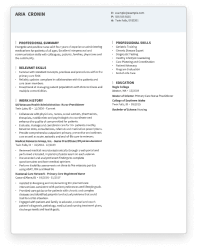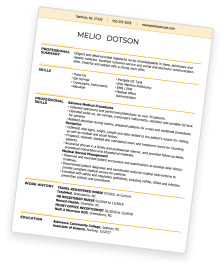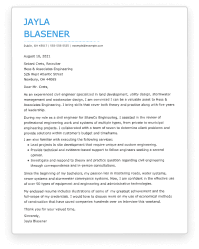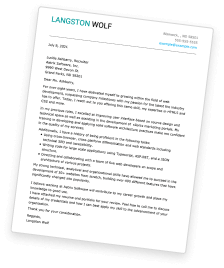Administrative Assistant Resumes: Overview
Administrative assistants are pivotal in ensuring organizations’ smooth and efficient operation across various industries. They are responsible for handling various administrative tasks, from managing schedules and organizing meetings to maintaining records and assisting with communication.
Administrative assistants can be found in a variety of settings, including:
- Corporate Offices
- Healthcare Facilities
- Educational Institutions
- Non-profit Organizations
To excel as an administrative assistant, it’s essential to possess strong organizational and communication skills, attention to detail, and proficiency in office software. A friendly demeanor and the ability to handle diverse tasks gracefully are also highly valued qualities.
Our administrative assistant resume examples are the first step to building a great resume. For more help, explore our collection of customizable resume examples and downloadable resume templates to take your career to new levels.
Administrative Assistant Resume Example
This meticulously crafted administrative assistant resume is a perfect example of how to expertly craft your qualifications to impress potential employers.
-
Professional Design:
The use of a clean, professional design with well-organized sections and bullet points ensures readability and keeps the focus on the candidate's qualifications as an administrative assistant.
-
Relevant Experience:
This resume example effectively highlights relevant work experience, such as streamlining office processes and enhancing communication, demonstrating the candidate's impact in previous administrative roles.
-
Quantifiable Achievements:
With specific examples such as "saved over $100,000 per year", this candidate provides unique context and value that helps them stand out.
-
Clear and Concise:
The resume provides a compelling summary of the candidate's relevant skills, work history, and achievements without unnecessary jargon that might make the reader lose interest.
Administrative Assistant Resume Sample
Here, we have another excellent resume sample for administrative assistant positions. Take a close look at its aesthetic choices and the type of content included to better understand how to construct your next resume.
-
Strategic Keyword Usage:
The inclusion of relevant administrative assistant keywords and key phrases throughout the resume ensures it's optimized for applicant tracking systems (ATS), increasing the chances of getting noticed by recruiters.
-
Visual Elegance:
The resume's stylish layout, including eye-catching fonts and formatting, creates a professional and visually engaging document that sets it apart from the ordinary.
-
Effective Summary:
The resume summary engages the reader and helps promote relevant hard and soft skills to bring attention to the candidate's qualifications as an administrative assistant.
-
Well Organized:
The resume is meticulously organized, presenting information in a clear, structured manner. It effectively communicates the candidate's qualifications, making it easy for employers to identify their strengths.
How to Write an Administrative Assistant Resume: A Step-by-Step Guide
When crafting your administrative assistant resume, following a structured approach is key to making a strong impression on potential employers. Here’s a step-by-step guide to help you create a winning resume:
-
Pick a Format:
There are three types of resume formats and you should pick the one that best fits your needs. The chronological resume format is the most common and focuses on job history.
The functional resume format is less common and not as ATS-friendly, however, it is good for those with less experience, like recent high school graduates, because it focuses on transferable skills. Finally, there is the combination resume format, which uses elements from both the chronological and functional approaches.
-
Contact Information:
Begin your administrative assistant resume with your contact details, including your full name, phone number, email address, and LinkedIn profile (if applicable). Make sure your contact information is current and professional.
-
Summary or Objective:
Highlight your unique administrative assistant qualifications with a compelling opening statement or a purposeful introduction. A resume summary, typically consisting of 2-3 sentences, shines a spotlight on your relevant background, skillset, and what you bring to the position.
An objective statement outlines your career aspirations and how they align with your pursuit of a customer service role. Choose the one that best fits your situation and personalize it for each specific job application.
-
Work History:
Detail your work experience in reverse chronological order, starting with your most recent position. Include the job title, the name of the company, dates of employment, and a brief description of your responsibilities and accomplishments. Focus on quantifiable achievements to demonstrate your impact.
-
Skills:
Highlight your relevant administrative skills in areas such as office software proficiency, communication, organization, and multitasking. Be sure to match your skills with the requirements of the job you're seeking and include both hard and soft skills.
-
Education:
List your educational background, including your degree(s), the name of the institution, graduation date, and any honors or certifications. If you're an entry-level applicant, place this section near the top of your resume.
-
Additional Sections (optional):
Depending on your unique qualifications, consider adding additional sections like computer certifications, languages spoken, or organizational volunteer work to further enhance your resume.
Key Skills and Certifications For Administrative Assistant Resumes
Navigating an administrative assistant role requires a blend of hard skills and soft skills, along with relevant certifications that can set you apart in the job market when you include them on your resume.
Top 5 Hard Skills for Administrative Assistants
- Microsoft Office Suite: Proficiency in Word, Excel, PowerPoint, and Outlook is essential for document creation, data analysis, and effective communication.
- Data Entry: Accurate and efficient data entry skills are crucial for maintaining records and databases.
- Calendar Management: The ability to efficiently organize and manage schedules, appointments, and meetings is a hallmark of a great administrative assistant.
- Office Equipment Proficiency: Familiarity with office equipment such as copiers, scanners, and fax machines is often required for day-to-day tasks, as well as a general comfort with computers.
- Document Management: Effective file organization and management skills ensure easy access to critical information.
Top 5 Soft Skills for Administrative Assistants
- Communication: Strong verbal and written communication skills are vital for clear and effective correspondence with colleagues and clients.
- Organizational Skills: administrative assistants must excel in time management, multitasking, and maintaining a well-structured workspace.
- Attention to Detail: Precision is key for tasks like proofreading documents, managing schedules, and handling sensitive information.
- Adaptability: The ability to thrive in a fast-paced environment and adapt to changing priorities is a valuable trait.
- Customer Service: Exceptional customer service skills are essential, as administrative assistants often serve as clients and visitors’ first point of contact.
Top 5 Certifications for Administrative Assistants
- Certified Administrative Professional (CAP): A widely recognized certification that validates your expertise in administrative roles.
- Microsoft Office Specialist (MOS): Demonstrating advanced technical skill proficiency in Microsoft Office can enhance your qualifications.
- Certified Professional Secretary (CPS): This certification focuses on administrative and management skills.
- Certified Administrative Professional with Organizational Management (CAP-OM): Ideal for those seeking to excel in organizational leadership roles.
- Notary Public Certification: Depending on the job and location, becoming a Notary Public can be valuable, especially in legal or financial environments.
Incorporating these resume skills and certifications can make you a highly desirable candidate for any administrative assistant position because they show a high level of professionalism and commitment to the job.
Helping Job Seekers Like You
10 Tips For Writing An Administrative Assistant Resume
- Tailor to the Job: Customize your resume for each application by highlighting the skills and experiences most relevant to the specific administrative assistant position you’re pursuing.
- Use Action Verbs: Start bullet points with strong action verbs like “managed,” “coordinated,” or “implemented” to convey your contributions effectively.
- Quantify Achievements: Whenever possible, use quantifiable metrics (e.g., “increased efficiency by 20%”) to demonstrate your impact and achievements.
- Highlight Software Skills: Emphasize your proficiency with computers and office software (Microsoft Office Suite, Google Workspace, etc.) in a dedicated skills section.
- Showcase Soft Skills: Describe soft skills like communication, organization, and adaptability in both your resume summary and work experience.
- Include a Resume Summary: Craft a concise resume summary that provides a snapshot of your qualifications, skills, and career goals.
- Detail Work Experience: For each job, provide specific job duties, accomplishments, and responsibilities that directly relate to the administrative assistant role.
- Education Placement: If you have limited work experience, consider placing your education section higher on the resume, near the top.
- Professional Summary: Include any relevant memberships in professional organizations, such as the International Association of Administrative Professionals (IAAP).
- Proofread Thoroughly: Eliminate errors by proofreading your resume carefully, and consider asking a trusted colleague or friend for feedback.
- Keyword Optimization: Incorporate relevant keywords from the job posting to increase your chances of passing through Applicant Tracking Systems (ATS).
- Use a Clean Format: Choose a clean and professional resume format with consistent fonts, bullet points, and headings to enhance readability.


Save Time With Hloom's Resume Builder!
Key Takeaways
Tailoring your administrative assistant resume to match the specific job you're applying for is crucial.
A successful administrative assistant should possess a combination of hard skills (e.g., software proficiency) and soft skills (e.g., communication and organization) to excel in the role.
Consider obtaining certifications like Certified Administrative Professional (CAP) or Microsoft Office Specialist (MOS) to enhance your resume’s marketability.
Use quantifiable achievements and metrics in your resume to demonstrate your impact and contributions in previous administrative roles.
A well-structured resume with proper proofreading is essential to leaving a positive impression on potential employers.
Save Time With Hloom's Resume Builder






